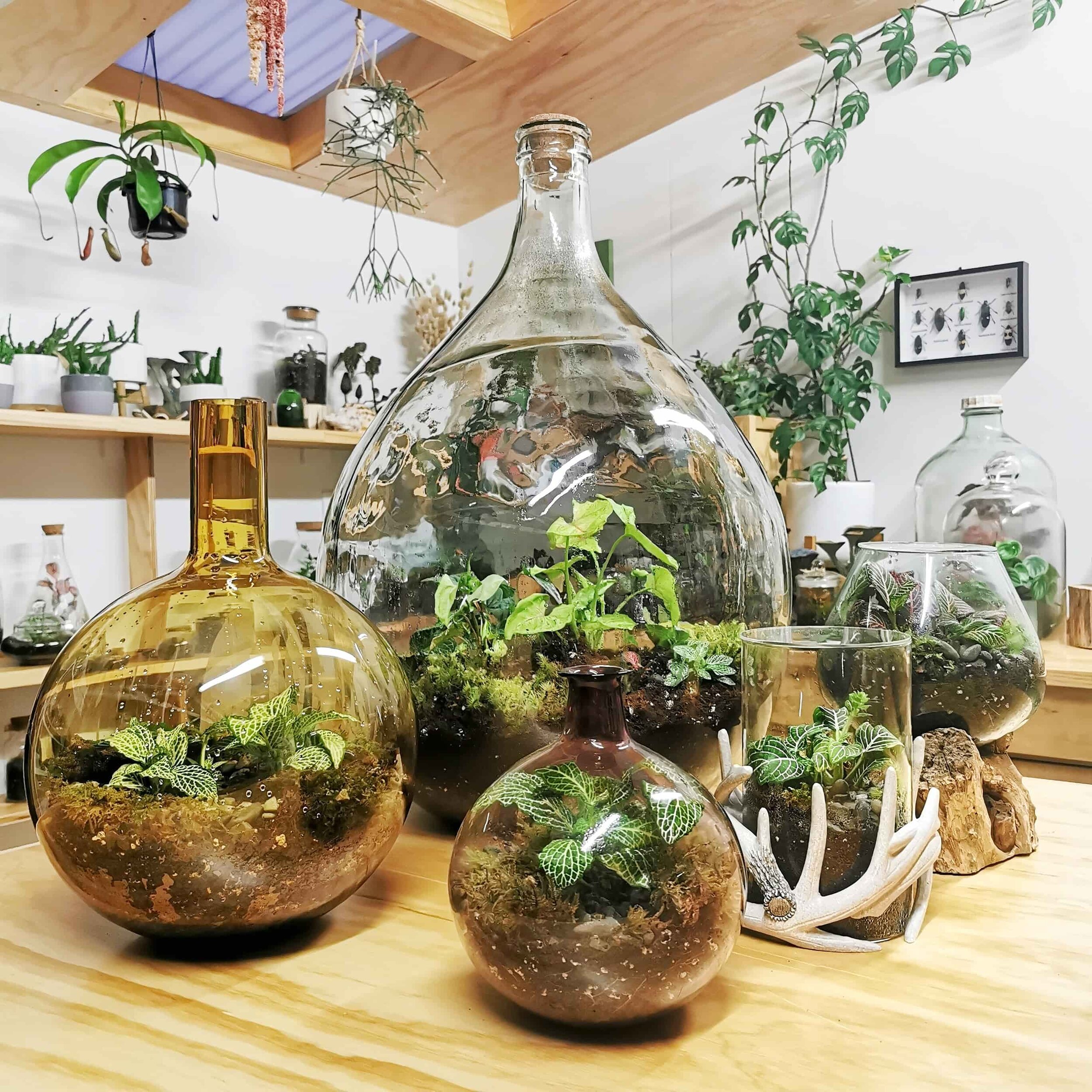
Terrariums?!! What are they?!
Are they magic?!
Here at Jungle Botanics there is nothing we like talking about more.
Care instructions
Terrariums are very low maintenance, however there are a few things you need to do that will keep your little ecosystem healthy and happy.
Light: Bright, indirect light. Near a window but not close enough for your plants to burn through the glass. Terrariums are typically made with tropical plants and mosses that do not need direct sunlight, so make sure it’s in the right spot and every so often turn it around so that your plants grow evenly. Tropical plants are used to growing under the canopy of the rain forest, so they only receive dappled, indirect light.
Air: Only remove the lid for watering and maintenance. If there are large droplets of condensation forming that do not go away, leave the lid off for a few hours to dry out a bit. Remove any mould or dead foliage as soon as possible.
Water: Each day you should see condensation forming in your Terrarium. This is the natural water cycle that makes your ecosystem self sustaining. Water sparingly and only when this condensation has mostly dried up and the soil layer looks dry. When you do water your Terrarium (which could be every few months or longer depending on how tight the seal) make sure you introduce it slowly, only adding a few squirts from a spray bottle or a few drops as over watering your Terrarium will lead to mould, root rot and too much condensation. If this does happen, remove the lid overnight or until your Terrarium has dried out a bit and then replace the lid and monitor.
Maintain: Wipe down the inside and outside of the glass with a paper towel or lint free cloth every few months to keep your Terrarium looking fresh (this makes such a huge difference). Trim any plants that are outgrowing the space with a pair of clean scissors.
Where it all began.
Over 150 years ago, botanist Nathaniel Bagshaw Ward was the first person to accidentally discover the Terrarium as we know it today. Whilst doing some experiments that involved putting a chrysalis in a jar and observing moisture content, he noticed with fascination as fern spore in the jar grew, germinated into a plant, and this jar resulted in the first terrarium.
This quickly became popular among the English in the Victorian Era.
It was initially known as the ‘Wardian Case’ and over the years has gone through several resurgences as people crave the magic of the natural world in an easy, low maintenance form. True Terrariums are sealed with a lid, acting as mini greenhouses with their water vapour being recycled within. Warmth from the sun causes moisture to evaporate from the plants and soil, which then turns into condensation on the cool insides of the glass vessel. Just like Mother Natures’ water cycle, the condensation turns into ‘rain’ and falls back to the soil, watering the plants inside.
This is what makes a Terrarium a self sustaining ecosystem, needing only occasional maintenance such as pruning, wiping down the glass and misting every few months if looking dry. The soil provides nutrients for the plants, then – as is the natural order of things – those nutrients are replenished as the plants die and decompose into the soil.
Closed Terrariums.
True closed Terrariums are always sealed with a lid, meaning they are much lower maintenance and mostly self sufficient.
These kinds of ecosystems require a healthy balance, so can be a bit harder to set up than an open Terrarium. Its important to not over water a closed Terrarium, they should only need a small misting of water every few months. If there’s condensation forming on the glass, then your plants are being watered and you don’t need to add more.
Plant selection for a closed Terrarium is very important as plants in this environment need to be able to handle the warmer temperatures and high humidity of this environment. Think ferns, mosses, begonias, fittonias for example, as opposed to succulents and cacti which will rot in this moist environment.
Most plants selected for closed Terrariums are found in the wild growing under a big jungle canopy, with only filtered and dappled sunlight, so they need these conditions in a Terrarium too.
Never place your Terrarium in direct sunlight as this will turn your ecosystem into a hot mess and your plants will quickly burn and die. The best rule of thumb is to place your Terrarium in a north facing window (think cooler morning light), somewhere it can see the sky outside but not in direct line with the sun streaming in the window. Once your Terrarium has found its happy place it can survive for many years with very little maintenance.
Open Terrariums.
This is not a true Terrarium. Open Terrariums are planters without drainage, usually consisting of drainage layers, a light soil mix and planted with succulents and cacti and the big difference being they are not sealed with a lid!
Mosses and ferns will not thrive in these conditions as they need much higher humidity, so make sure not to combine succulents and humidity loving plants in an open Terrarium. Open Terrariums need watering more often and are not self-sustaining like closed Terrariums. This kind of Terrarium will need very bright light as succulents and cacti are used to living outside in bright sunlight, whereas closed Terrariums contain plants that are used to living under a big jungle canopy with filtered and dappled sunlight, therefore are more suited to being indoor plants. Be careful not to over water your open Terrariums as it can cause root rot. If they get quite leggy and pale looking, this is an indication that they need much more light.



